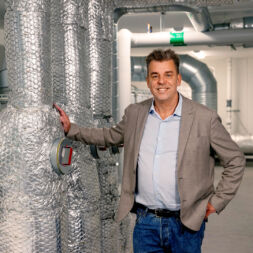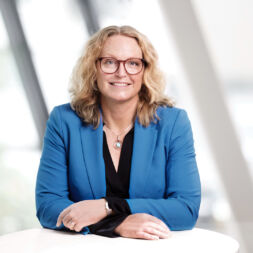-
Home
-
About Elfack
-
Exhibitors
-
Activities
-
Plan your visit
-
For exhibitors
-
Sweden’s smartest neighbourhood takes shape
Tamarinden in Örebro is paving the way for the climate-smart neighbourhoods of the future, in which a unique and localised electricity supply system can reduce, produce, store and share energy.
Planning for Sweden’s smartest neighbourhood – Tamarinden is starting to take physical shape. The neighbourhood consists of ten real estate areas with a total of around 800 homes. Two of the five parts of the neighbourhood are expected to be completed in early 2025.

– You could say that Tamarind is an upscaling of something we have done and believe in ourselves. And that is to ensure that buildings become smart together with other buildings – a symbiosis that achieves new capabilities. The basis of Tamarinden is that you multiply benefits by connecting several buildings, thereby creating new services, opportunities and capabilities such as energy storage and district heating, says Jonas Tannerstad.
Jonas is Head of Electricity and Automation at the municipal housing authority Örebrobostäder (ÖBO for short). He continues:
– The most important thing about Tamarinden is that we are learning how the existing housing stock in Örebro can be converted and become part of a larger whole.
The aim, in addition to saving energy, is to increase the use of locally produced and renewable energy, reduce peak loads, relieve the electricity grid and improve flexibility.
– It’s about ensuring that buildings become smart by interacting with other buildings, which opens up new opportunities. Connecting several buildings creates new services and functions, such as energy storage of electricity, Jonas says.
District heating and electricity shared via separate networks
Although the area is not yet built, the energy solutions need to be in place soon.
– Work is currently underway, including the construction of two technical networks – one for sharing electricity and one for sharing district heating. These need to be in place, even if the whole area isn’t finished, so that when buildings have been completed they can start using the networks. That’s where we are now, ensuring that the infrastructure is ready in time for Serneke and Tornet to connect their properties at the end of this year and the beginning of next, Jonas explains.
Technological developments require faster bureaucracy

Energy sharing between properties is thus the unique feature of residential areas like Tamarinden, where the electricity grid is jointly owned, and maintenance and operation of the grid is managed by a community association. Electricity that is not consumed within one’s own property can thus be transferred to other properties within the same energy community via the local electricity grid.
Ulrika Jardfelt, co-founder of Conatus, which helps property owners reduce energy use, has extensive experience in the energy transition. She also chairs an energy community in Hammarby Sjöstad, a sister project to Tamarinden. Ulrika points out that Sweden is lagging behind in adapting to EU regulations for energy communities.
– We need to have a common understanding of what energy communities are and how they can contribute to a more stable and greener energy system. It’s important that technological development is not hampered by lengthy regulatory processes, she says.
Projects breaking new technological ground can face regulatory challenges when bureaucracy does not keep up with technological developments.
– One example is the IKN legislation, which previously prevented us from laying electricity cables in the ground. We managed to resolve that issue through a decision by the Energy Markets
Inspectorate. But when that problem was solved, the next one arose, Jonas says.
The Swedish Tax Agency believes that the energy shared between property owners via solar cells should be taxed in a way that challenges the project.
– The Swedish Tax Agency says that electricity shared by one property owner with another property owner must be taxed, because they see all solar cell installations as one big installation. They lump all the solar installations together, even though we are five different property owners with separate legal organisation numbers, Jonas adds.
Tamarinden and Hammarby Sjöstad have developed their own technical solutions for energy storage, sharing and smart grids. The aim is to use existing infrastructure for energy sharing, without building new networks. Energy communities can be created through digital platforms that enable virtual sharing and facilitate the energy transition for apartment blocks and larger areas of real estate.
– In Hammarby Sjöstad, the ambition is to use the existing electricity network and meters instead of building a completely new infrastructure, which already works well. We call it virtual sharing. At the same time, we need to show, as with Tamarinden in Örebro, that we can share electricity with ourselves, Ulrika says.
Technological advances at the forefront of the energy transition
Projects such as Tamarinden are paving the way for the future of property and housing in Sweden, where the sharing model itself helps to relieve the electricity grid and reduce capacity shortages. Something that is a major problem both locally and nationally. Ulrika Jardfelt emphasises the importance of locally produced energy within energy communities being tax-free. She also thinks that reduced grid fees should be introduced to promote the transition.
– If we can produce and use electricity locally, like in Tamarind, it would reduce the load on the national grid and create financial savings. But to achieve this, the tax rules must be reviewed, she concludes.
Jonas Tannerstad will be speaking at Elfack 2025, northern Europe’s largest meeting place for the electricity and energy industry. Using the Tamarinden project as a starting point, he will talk about how we can combine energy storage, smart buildings and renewable energy to create a sustainable way of living in the future.
FACTS:
The project ‘Promoting System Change with Locally Shared Energy’ includes two pilot areas: the newly built Tamarinden in Örebro and the existing Hammarby Sjöstad area in Stockholm. The project will investigate energy communities and their potential to renew the Swedish energy system, with the aim of meeting future energy needs while protecting the climate and the environment. The pilots serve as national models for how energy communities can be scaled up in other municipalities and housing associations. Together, they represent 80 per cent of Sweden’s property stock. The four-year project is funded by the Swedish Energy Agency and has a budget of SEK 59 million.